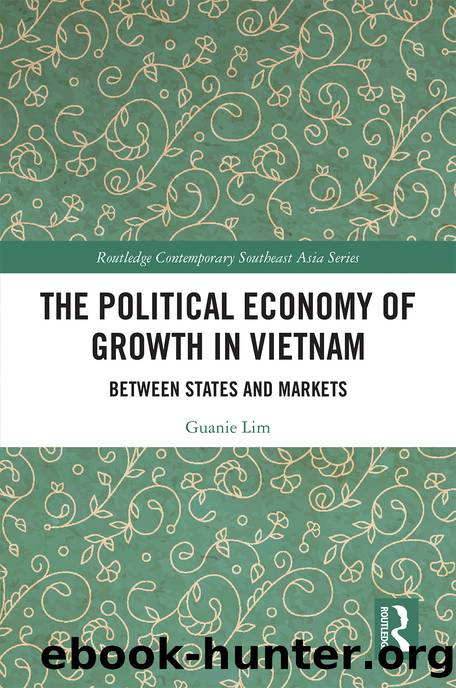The Political Economy of Growth in Vietnam by Lim Guanie;

Author:Lim, Guanie;
Language: eng
Format: epub
Publisher: Taylor & Francis Group
Published: 2021-12-15T00:00:00+00:00
Fortuitous growth amidst international pressure
From its humble beginning in the 1990s to its current phase, the Vietnamese motorcycle industry has come of age in its transformation into the worldâs fourth largest motorcycle market (in terms of units produced). As of 2017, it controlled 7.9% of the global market share, trailing only India, China, and Indonesia. In addition to the increase in the number of manufactured motorcycles, Vietnam has groomed a few Vietnamese-owned motorcycle assemblers (such as Sufat) that might eventually become TNCs in their own right. Moreover, Vietnamese-owned component suppliers have successfully achieved high levels of product quality and competitiveness, helping the industry attain local content ratios in excess of 90% in a relatively short period. The vitality of these domestic firms, in addition to that of the motorcycle TNCs and their cohort of FDI suppliers, positions Vietnam as an attractive motorcycle manufacturing and export hub in Southeast Asia.
Vietnamâs achievement is especially noteworthy as India, China, and Indonesia all developed their motorcycle industries before Vietnam did and benefited from their much larger domestic populace. These two factors mean that, unlike Vietnam, these countries enjoyed a longer period to develop their motorcycle industries and a stronger bargaining chip vis-Ã -vis motorcycle TNCs that were interested in entering their markets. In addition, these three countries did not need to deal with international competition immediately after the inception of their motorcycle industries. Vietnamâs success is even more remarkable as the Vietnamese motorcycle industry grew meaningfully only since the 2000s. Prior to the 2000s, it grew rather slowly.
In terms of policy, it can be argued that the Vietnamese state has utilized a series of direct and indirect policy tools to uplift the motorcycle industry. It was also prudent enough to discontinue its preâdoi moi ISI stance by attracting FDI from the major motorcycle TNCs, accessing their technological knowledge. Overall, much like Limâs (2018) thesis, it can be argued that the Vietnamese state is adept in attracting the investment dollars of the motorcycle TNCs and their cohort of suppliers, but it has proven only moderately successful in implementing policies to more deeply embed their operations and disseminate critical engineering knowledge to the domestic firms. For instance, in the immediate years after the doi moi (i.e. the first stage of the analysis detailing the motorcycle industry), the state depended on tariffs for imported components, the local content policy, and import restrictions on CBUs to promote technological spillover from the motorcycle TNCs, in addition to some incentives such as tax breaks and subsidized land. These policies were appealing to the motorcycle TNCs, evidenced by the establishment of the Vietnamese operations of several of these brand name firms during this period. However, it enjoyed limited success in stimulating the broader industry as the motorcycle TNCs avoided interaction with the domestic component suppliers with ease, sourcing their components from their own first-tier suppliers, which followed them into Vietnam. In some cases, they even manufactured these components in-house. To a large extent, such an outcome is not entirely unexpected as Vietnam did not possess strong motorcycle component and/or machinery tools industries during that era.
Download
This site does not store any files on its server. We only index and link to content provided by other sites. Please contact the content providers to delete copyright contents if any and email us, we'll remove relevant links or contents immediately.
Zero to IPO: Over $1 Trillion of Actionable Advice from the World's Most Successful Entrepreneurs by Frederic Kerrest(4044)
Machine Learning at Scale with H2O by Gregory Keys | David Whiting(3611)
Harry Potter and the Goblet Of Fire by J.K. Rowling(3606)
Never by Ken Follett(3520)
Ogilvy on Advertising by David Ogilvy(3327)
Shadow of Night by Deborah Harkness(3171)
The Man Who Died Twice by Richard Osman(2804)
Book of Life by Deborah Harkness(2716)
My Brilliant Friend by Elena Ferrante(2698)
How Proust Can Change Your Life by Alain De Botton(2609)
0041152001443424520 .pdf by Unknown(2592)
Will by Will Smith(2573)
The Tipping Point by Malcolm Gladwell(2554)
How to Pay Zero Taxes, 2018 by Jeff A. Schnepper(2497)
Purple Hibiscus by Chimamanda Ngozi Adichie(2480)
Hooked: A Dark, Contemporary Romance (Never After Series) by Emily McIntire(2414)
Rationality by Steven Pinker(2148)
Borders by unknow(2115)
Daughter of Smoke and Bone by Laini Taylor(2077)
